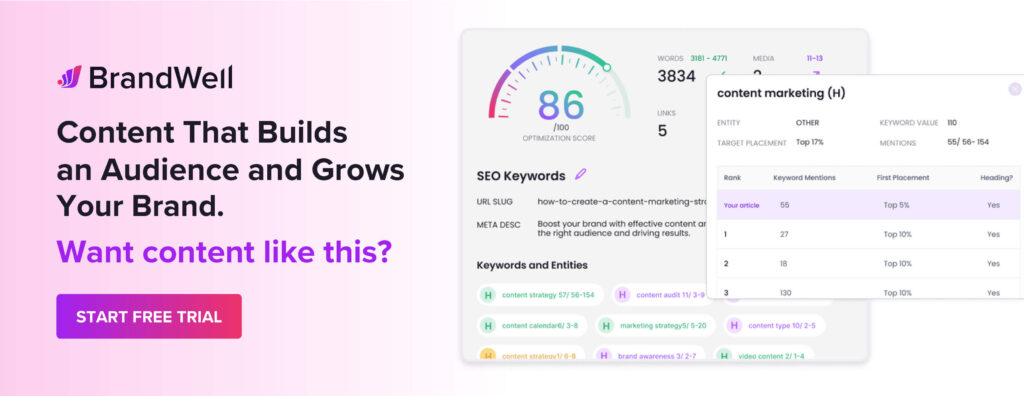Discover top guides, trends, tips and expertise from AIO Writers
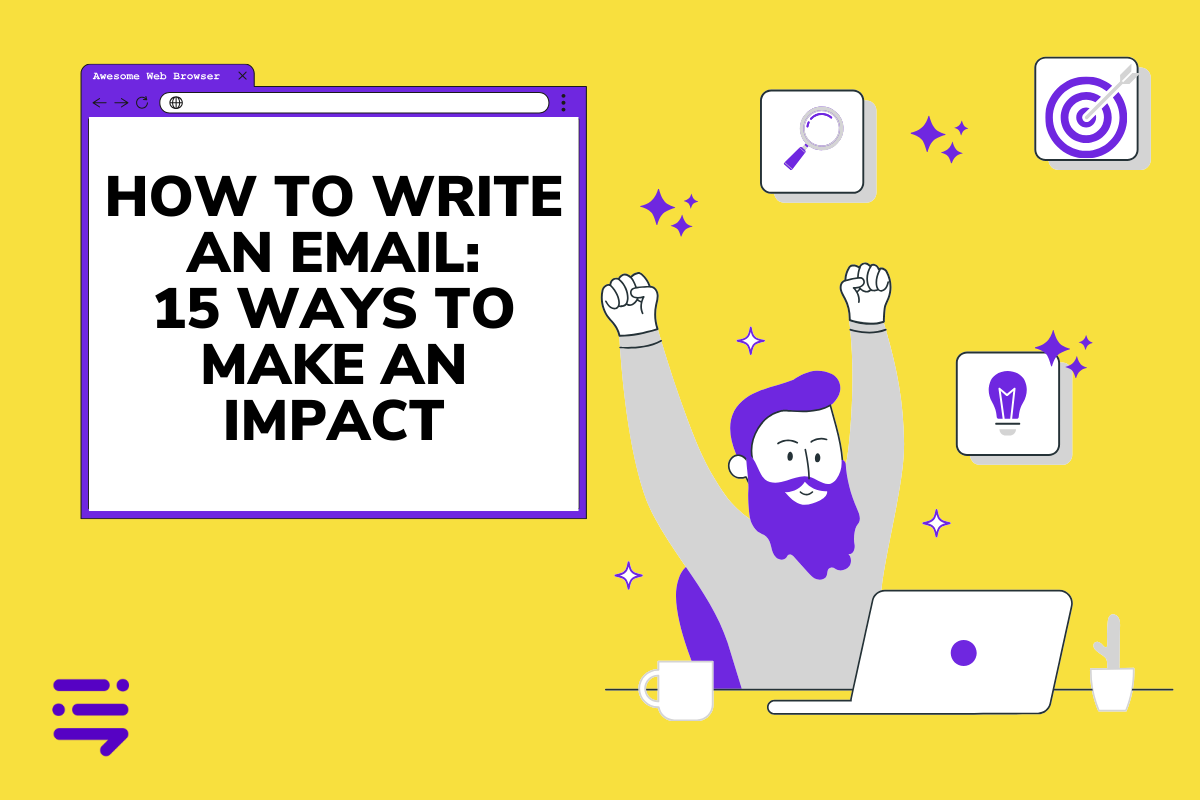
Email marketing has come a long way since those days of simply writing plain-text letters. Today our inboxes are full of fancy promotional material from top brands featuring photos, videos, and all sorts of interactive elements.
But how to write an email that actually gets opened and read by your intended recipients?
According to a 2022 report from Campaign Monitor, only 21.5% of emails get opened on average. The retail industry has the lowest email open rate at only 17% while the education sector has the highest at 28.5%.
In this post, we will share a few email writing tips to help you craft the perfect sales or marketing letter that delivers results.
Table Of Contents:
- How to Write an Email: The Basics
- How to Write a Great Email Subject Line
- Structuring the Body of Your Email
- Polishing Your Email Greeting and Closing
- How to Write an Email: 15 Ways to Make an Impact
- What is Email Etiquette?
- Tips on How to Write a Great Marketing Email
- Email Marketing Best Practices
- FAQs – How to Write an Email
- Conclusion
How to Write an Email: The Basics
Writing an email might seem straightforward, but there are a few key steps that can help you communicate more effectively and make a positive impression on the recipient.
Here are the 7 basic components of a good email:
- Clear and Concise Subject Line: Think of the subject line as the headline of your email. It should give the recipient a clear idea of what to expect. Keep it concise and relevant, and avoid being cryptic.
- Greeting: Start with a friendly greeting. If you know the person well, a simple “Hi [Name]” works. If it’s a more formal situation or you don’t know them, a polite “Dear [Title] [Last Name]” is appropriate.
- Introduction: Briefly introduce yourself and establish the purpose of your email. Be direct and to the point. No need to write a novel in the first paragraph.
- Body of the Email: Organize your thoughts in a logical order. Use paragraphs to break up large chunks of text, making it easier to read. Each paragraph should focus on a specific point.
- Call to Action: Clearly state what you want the recipient to do or respond to. Whether it’s setting up a meeting, signing up for an email list, or just acknowledging receipt, make it evident.
- Closing: End your email with a closing phrase, such as “Best regards,” “Sincerely,” or “Thank you.” It adds a professional touch. Don’t forget to include your name.
- Signature: If you’re writing a formal or professional email, include a signature block with your full name, title, and contact information. In a more casual setting, your name is usually sufficient.
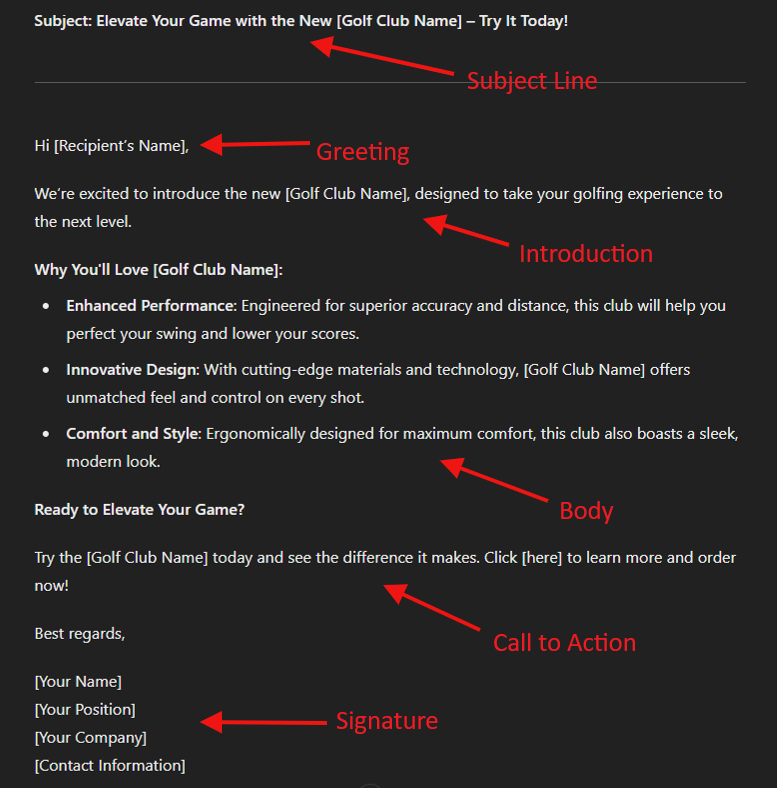
Remember, the goal is to communicate effectively and make the recipient’s reading experience as smooth as possible.
Now let’s break down how to write an email step by step, going from the subject line to closing.
How to Write a Great Email Subject Line
A great email subject line serves as the gateway to your message. It’s the first thing recipients see and often determines whether they’ll open the email or not.
Here are a few reasons why subject lines matter so much:
- Grabs Attention: In an inbox full of messages, a compelling subject line stands out. This helps ensure that your email doesn’t get lost in the sea of unopened mail or, worse, gets dumped in the trash folder.
- Sets Expectations: Subject lines give a snapshot of what’s inside the email, letting readers know if it’s relevant to them or requires urgent action.
- Saves Time: With clarity from the start, recipients can prioritize how and when to read your email without needing to scan through its content first.
- Improves Open Rates: An engaging subject line is more likely to be opened than one that’s vague or generic, which directly impacts how effective your communication will be.
Remember, the more enticing your subject line, the higher the chance the recipient will not only read your email but send a timely response.
Research shows that 47% of people open emails based on the subject line alone. How to write an email with a great subject line?
- Make it relevant: Tailor the subject to your audience’s interests or needs. This personal touch can make all the difference.
- Tell don’t sell: Your email should be informative rather than promotional. Make your recipient feel valued, not targeted.
- Keep it short and sweet. Subject lines are ideally under 50 characters. Long or complex lines can get cut off in mobile views or simply lose reader interest.
- Avoid spam triggers: Steer clear of ALL CAPS, excessive exclamation points!!!, and spammy words such as “free” or “buy now.”
If you find yourself stuck staring at a blank screen, you can use AI to brainstorm ideas for a great email subject line. Here are some suggestions written by BrandWell’s AI Agent for email marketing, Ethan:
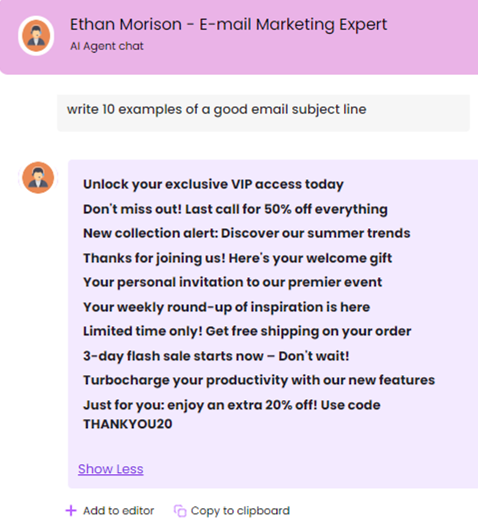
Always personalize your email with the name of the recipient. Subject lines that address an individual personally are more likely to get clicked than generic opening lines.
A good rule of thumb: Think about what would make you want to open an email — that’s usually a sign of a strong subject line!
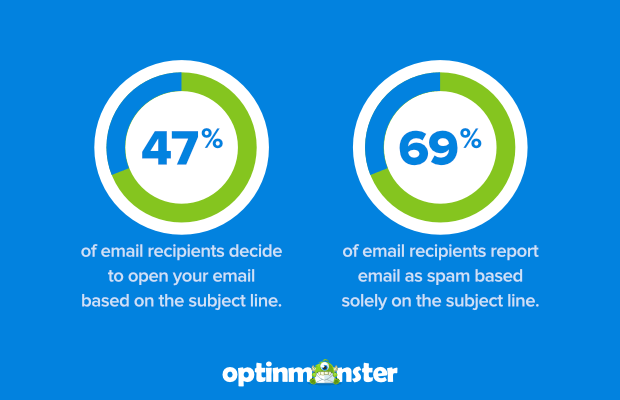
Source: OptinMonster
Structuring the Body of Your Email
On average, people only spend 9 seconds looking at an email.
This is why it’s crucial to learn how to write an email that holds your reader’s attention while conveying your message effectively.
Opening Line: Start with a personal touch or acknowledgment if you know the recipient, followed by a direct statement about the purpose of your email.
Structure: Avoid overloading information in one paragraph; instead, use bullet points for multiple ideas or steps. This helps the reader grasp your message quickly and saves their time too.
Clarity: Be clear and concise — get straight to what you want without unnecessary details.
Tone: Match the tone of your email with your audience. Formal for business communications, more relaxed for friends or colleagues you know well.
Action Items: Clearly state any required actions. If there’s something you need from the recipient, make that stand out so they can’t miss it.
Remember not just WHAT you write but HOW matters.
Here’s a more detailed guide on how to start an email that hooks your reader.
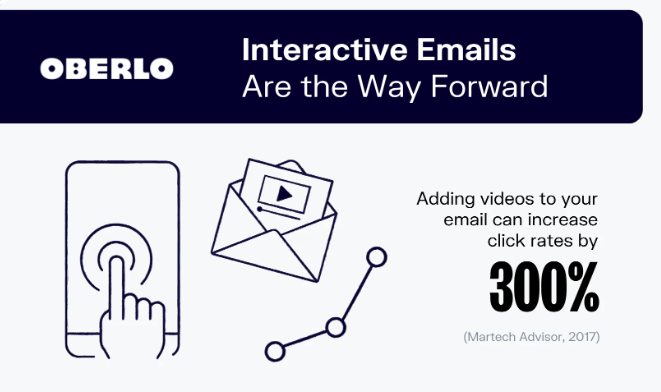
Source: Oberlo
Polishing Your Email Greeting and Closing
The start and end of your email set the tone for the entire message. So, let’s get this right.
Formal greetings like “Dear Sir/Madam” are a safe bet in professional emails, but if you know the recipient well enough, feel free to use their first name.
Avoid generic closings such as “Best.” Instead, opt for something more personal like “Kind regards,” or “Sincerely.”
Remember that each conversation has its unique context so there isn’t a one-size-fits-all approach when it comes to polishing your email greeting and closing. However, following these tips can help ensure professionalism while keeping a friendly tone.
How to Write an Email: 15 Ways to Make an Impact
When sending an email to clients, maintain a professional and courteous approach to build and maintain positive relationships.
Here are 15 things to keep in mind when sending an email to your customers.
- Purpose and clarity: Clearly state the purpose of the email in the subject field and the opening paragraph. Make sure your message is concise, easy to understand, and free from ambiguity.
- Personalization: Address the client by their name to create a personalized connection. Avoid using generic salutations like “Dear Sir/Madam.”
- Tone and language: Use a friendly and professional tone that matches the nature of your relationship with the client. Avoid jargon and technical language unless you are sure the client will understand it.
- Proofreading: Always proofread your email before sending it to ensure there are no grammatical errors, typos, or formatting issues.
- Respect their time: Keep the email concise and to the point. Respect your client’s time by avoiding lengthy emails. Get to the main message quickly.
- Call-to-action: Clearly state what you expect from the client and include a call-to-action if necessary. For instance, set a deadline or request confirmation if you need them to reply.
- Relevant information: Provide all necessary details such as order numbers, dates, or reference numbers, to help the client easily identify the context of your message.
- Attachments: If you are sending any attachments, mention them in the email and ensure they’re relevant to the email’s content. Avoid attaching large files without compressing them first and make sure that the attached files are actually included before hitting send.
- Responsiveness: Respond promptly to any inquiries or requests from the client, showing them that their time is valued.
- Be positive and courteous: Maintain a positive and polite attitude, even if addressing concerns or issues. Avoid using aggressive language or blaming anyone.
- Avoid using all caps: Using all capital letters in your email can be perceived as shouting and is generally considered impolite.
- Confidentiality and data privacy: If the email contains sensitive or confidential information, ensure you use proper encryption and permissions for access.
- Unsubscribe option: If you are sending marketing emails, include an unsubscribe option to comply with anti-spam regulations and give clients the option to opt out.
- Mobile-friendly formatting: Make sure your email is readable and well-formatted on both desktop and mobile devices.
- Follow-up: If the email requires a response or action from the client, consider following up after a reasonable period if you haven’t heard back.
Here’s an example of a marketing email written by BrandWell:
Subject: Revolutionize Your Design Process with [Software Name] – Exclusive Launch Offer Inside!
Dear [Recipient’s Name],
Are you ready to elevate your design projects to a whole new level? We are thrilled to introduce [Software Name], the ultimate design software crafted to transform your creative process and bring your ideas to life with unprecedented ease and efficiency.
Why [Software Name]?
🔹 Intuitive Interface: Designed with you in mind, our user-friendly interface ensures that you can dive right into your projects without a steep learning curve.
🔹 Powerful Tools: From advanced vector editing to comprehensive 3D modeling, [Software Name] is packed with powerful features that cater to every design need.
🔹 Seamless Collaboration: Work effortlessly with your team in real-time, share feedback, and make edits on the fly with our cloud-based collaboration tools.
🔹 Extensive Asset Library: Access a vast library of templates, fonts, and stock images to enhance your designs and streamline your workflow.
🔹 Cross-Platform Compatibility: Whether you’re on a PC, Mac, or mobile device, [Software Name] ensures your work is accessible anytime, anywhere.
Exclusive Launch Offer!
To celebrate our launch, we’re offering an exclusive 20% discount on all subscriptions for the first three months. Don’t miss this opportunity to experience the future of design at a fraction of the cost!
Claim Your Discount Now!
- Visit [Website URL].
- Choose your preferred subscription plan.
- Enter the promo code: LAUNCH20 at checkout.
Join the growing community of designers who are transforming their creative processes with [Software Name]. Click the link below to get started and take advantage of this limited-time offer.
[Get Started Today!]
Thank you for being a part of our journey. We can’t wait to see the incredible designs you create with [Software Name].
Best regards,
[Your Name]
[Your Position]
[Your Company]
[Contact Information]P.S. Follow us on [Social Media Links] for tutorials, tips, and inspiration!
Remember, every email you send to clients reflects your professionalism and the image of your company, so approach each communication thoughtfully and with care.
What is Email Etiquette?
Email etiquette equates to the principles and guidelines that dictate how we interact with each other via email. These social norms are essential in maintaining a professional tone, especially when dealing with business communications.
In today’s digital age where text messages and phone conversations involving business matters are increasingly common, it’s easy for our written communication skills to slip up occasionally. However, this doesn’t mean we should let casual responses take over our professional correspondence.
A poorly composed email subject may end up in the spam filter instead of getting attention from its intended recipient, while a respectful salutation sets the right tone for any conversation.
Your choice of words can either build relationships or create barriers between you and your recipient. Therefore, you must get your message across effectively without taking too much of their time.
Professionalism Starts With Your Email Address And Signature
The first step towards achieving professionalism starts with having a suitable email address. A good rule of thumb is to use your full name followed by @yourcompanyname.com (or .org/.net). This way, people will instantly recognize who they’re receiving emails from, which enhances trustworthiness as well as brand identity.
Next comes crafting an appropriate email signature. Include important details like your name, title/position, phone number(s), and website URL(s).
If you’re emailing multiple recipients who don’t know each other well enough to share their contact information freely, use BCC (Blind Carbon Copy). This keeps everyone’s emails private and helps prevent spam messages.
Check Your Recipient List
You know what they say about first impressions? Well in the world of email marketing, that’s your “To” field. A wrong address can be as damaging as careless email mistakes elsewhere in your message.
A misspelling here or a domain name error there could lead to some serious issues — think confidential information landing in the inbox of unintended recipients.
So before hitting send on that business mail, always double-check each address for accuracy.
Remember that while casual responses may be acceptable during phone conversations involving friends or family members, business emails must remain professional at all times!
Every part plays a significant role so make sure everything falls neatly into place before hitting the “send” button!
Tips on How to Write a Great Marketing Email
Writing a great marketing email involves capturing the reader’s attention, providing value, and encouraging them to take action. Here are some tips to help you craft an effective marketing email:
Write Enticing Subject Lines
Your email subject line is the first impression you make on your recipient, especially in a professional setting. It can be the deciding factor between whether they open your message or toss it into their spam filter.
So how do we create clear and concise email subject lines?
- Be clear and concise: Keep your subject line brief and to the point. Aim for around 6 to 8 words if possible.
- Personalization: Use the recipient’s name to add a personal touch. Personalized subject lines tend to perform better in both marketing and general work emails.
- Create a sense of urgency: Use words that create a feeling of urgency or exclusivity, such as “Limited Time Offer” or “Last Chance.”
- Mention a benefit: Clearly state the benefit or value the recipient will get from opening the email.
- Use action-oriented language: Encourage action with verbs like “Discover,” “Learn,” “Grab,” or “Save.”
- Avoid spammy language: Avoid using all caps, excessive exclamation marks, or terms commonly associated with spam emails.
- Ask a question: Pose a thought-provoking question to pique the recipient’s curiosity.
- Be specific: If you’re promoting a sale or a discount, include the exact percentage or amount off in the subject line.
- Emphasize relevance: Make sure the subject line is relevant to the content of the email. Misleading subject lines can lead to distrust.
- Use humor when appropriate: If it fits your brand personality and the email’s content, a touch of humor can make the subject line stand out.
- Localization: If applicable, include location-specific information to make the email more relevant to the recipient.
- Avoid overused words: Stay away from overused words like “Free,” “Guaranteed,” or “Urgent,” as they may trigger spam filters.
- Mobile-friendly: Keep in mind that many recipients will view emails on mobile devices. Ensure the subject line is readable and impactful on smaller screens.
- Use emojis thoughtfully: Emojis can add visual appeal and convey emotion, but use them sparingly and make sure they are relevant to the content.
Remember, the subject line is your first opportunity to grab the recipient’s attention and encourage them to open your email. Put some thought into crafting a subject line that is compelling, relevant, and aligned with the content of your email.
Here are more examples of email subject lines for different niches:
Tech Gadgets:
“Unlock the Future: Discover Our Latest Tech Gadgets Today!”Fitness Equipment:
“Get Fit Fast: Check Out Our Game-Changing Fitness Gear!”Beauty Products:
“Glow Like Never Before: Explore Our New Beauty Collection!”Home Appliances:
“Transform Your Home: Innovative Appliances You’ll Love!”Fashion Accessories:
“Elevate Your Style: Trendy Accessories Just Dropped!”Food and Beverages:
“Taste the Difference: Gourmet Delights Await You!”Travel Gear:
“Adventure Awaits: Essential Travel Gear for Your Next Trip!”Books and Literature:
“Escape Into a New World: Must-Read Books of the Year!”Pet Supplies:
“Pamper Your Pet: Top Picks for Happy and Healthy Pets!”Outdoor Gear:
“Gear Up for Adventure: Explore Our Top Outdoor Essentials!”
These subject lines are designed to catch attention by emphasizing key benefits and creating a sense of excitement.
Be Concise
The secret sauce for crafting emails that hit home without dragging on is brevity. In this digital age where attention spans are dwindling, getting your point across quickly and effectively has never been more crucial.
How do we write concise emails?
- Start with a clear purpose: Know the main point of your email before you start writing. Make sure every sentence contributes to that purpose.
- Use short sentences: Keep your sentences brief and to the point. Avoid using long and complex sentence structures.
- Be direct: Get to the main message right away. Avoid unnecessary pleasantries or lengthy introductions.
- Limit your word count: Aim to keep your email as short as possible while still conveying all the necessary information.
- Avoid repetition: Eliminate unnecessary repetition or redundant phrases in your email.
- Remove filler words: Trim out filler words like “just,” “very,” “really,” “maybe,” and “quite.” They add little value to your message.
- Use bullet points or lists: Organize information in bullet points or lists to make it easier to read and digest.
- One topic per email: Stick to one main topic or subject in each email to avoid confusion.
- Use headings and subheadings: If your email covers multiple points, use headings and subheadings to organize the content.
- Proofread and edit: After writing your email, review it to identify areas where you can make it more concise.
- Avoid over-explanation: Provide enough information to convey your message but avoid going into unnecessary detail.
- Summarize when necessary: If your email covers a lengthy discussion or previous interactions, consider providing a brief summary at the beginning.
Let me show you an example of a concise email that gets straight to the point:
Subject: You’re Invited! Join Us for the Exclusive Launch of [Product Name]
Hi [Recipient’s Name],
We are thrilled to invite you to an exclusive event celebrating the launch of our latest innovation, [Product Name]!
Event Details:
- Date: [Event Date]
- Time: [Event Time]
- Location: [Event Venue], [Address]
- RSVP By: [RSVP Deadline]
Join us for an evening of excitement as we unveil [Product Name], designed to revolutionize [industry/field]. Be the first to experience its groundbreaking features, meet our team, and enjoy a night of celebration with fellow enthusiasts.
What to Expect:
- Live Demonstration: See [Product Name] in action with a live demo showcasing its unique capabilities.
- Expert Insights: Hear from our team of experts and get an in-depth look at the inspiration and development behind [Product Name].
- Networking Opportunities: Connect with industry leaders, influencers, and other guests.
- Exclusive Offers: Take advantage of special launch-day discounts and promotions.
We would be honored to have you join us for this special occasion. Please RSVP by [RSVP Deadline] to secure your spot.
[RSVP Now] (Link to RSVP)
If you have any questions or need further information, feel free to contact us at [Contact Information].
We look forward to celebrating with you!
Warm regards,
[Your Name]
[Your Position]
[Your Company Name]
[Contact Information]
[Follow Us on Social Media Links]P.S. Can’t make it to the event? Follow our live updates on [Social Media Platform] to stay in the loop!
Remember that writing concise emails is not about omitting essential information or sounding abrupt. It’s about presenting your message clearly and effectively while respecting the recipient’s time and attention.
Proofread Your Email
Mistakes can happen when you’re emailing, but frequent careless email mistakes might lead others to think less about your capabilities. Furthermore, even tiny errors could twist the meaning entirely, causing unnecessary confusion.
Among all the things to keep in mind when sending an email, proofreading is among the most crucial steps in ensuring that your email is error-free and professional. Here are some tips for effectively proofreading your email:
- Take a break: After writing an email, take a short break before proofreading. This allows you to approach the content with fresh eyes.
- Read aloud: Read the email aloud slowly. This helps you catch errors, awkward phrasings, and missing words.
- Check spelling and grammar: Use a tool like Grammarly to check spelling and grammar or paste the content into a word processor with proofreading features.
- Pay attention to homophones: Watch out for words that sound the same but have different spellings and meanings, such as “their,” “there,” and “they’re.”
- Look for typos: Carefully scan for typographical errors that spell-checkers might miss.
- Check punctuation: Ensure that commas, periods, question marks, and other punctuation marks are used correctly.
- Verify names and titles: Double-check the spelling of the recipient’s name and any titles you use.
- Review formatting: Check that the formatting is consistent throughout the email, including font styles, font sizes, and alignment.
- Confirm dates, numbers, and facts: If your email includes any dates, numbers, or factual information, verify their accuracy.
- Check links: If you have included hyperlinks, click on them to make sure they lead to the correct destinations.
- Consider the tone: Ensure that the tone of the email matches the recipient and the context.
- Get a second opinion: If the email is crucial or complex, ask a colleague or friend to review it for a fresh perspective.
- Read backward: Start at the end of your email and read each sentence backward. This helps you focus on individual words and prevents your brain from automatically filling in the missing information.
- Don’t rush: Take your time and proofread carefully. Rushing can lead to overlooking mistakes.
- Save a final draft: After proofreading, save a final draft and double-check that it contains all the necessary revisions.
Remember that even after proofreading, a few errors might slip through the cracks. However, taking the time to proofread significantly improves the overall quality and professionalism of your email.
With effective proofreading practices under our belt, we can now say goodbye to casual responses filled with typos and hello to well-crafted correspondence.
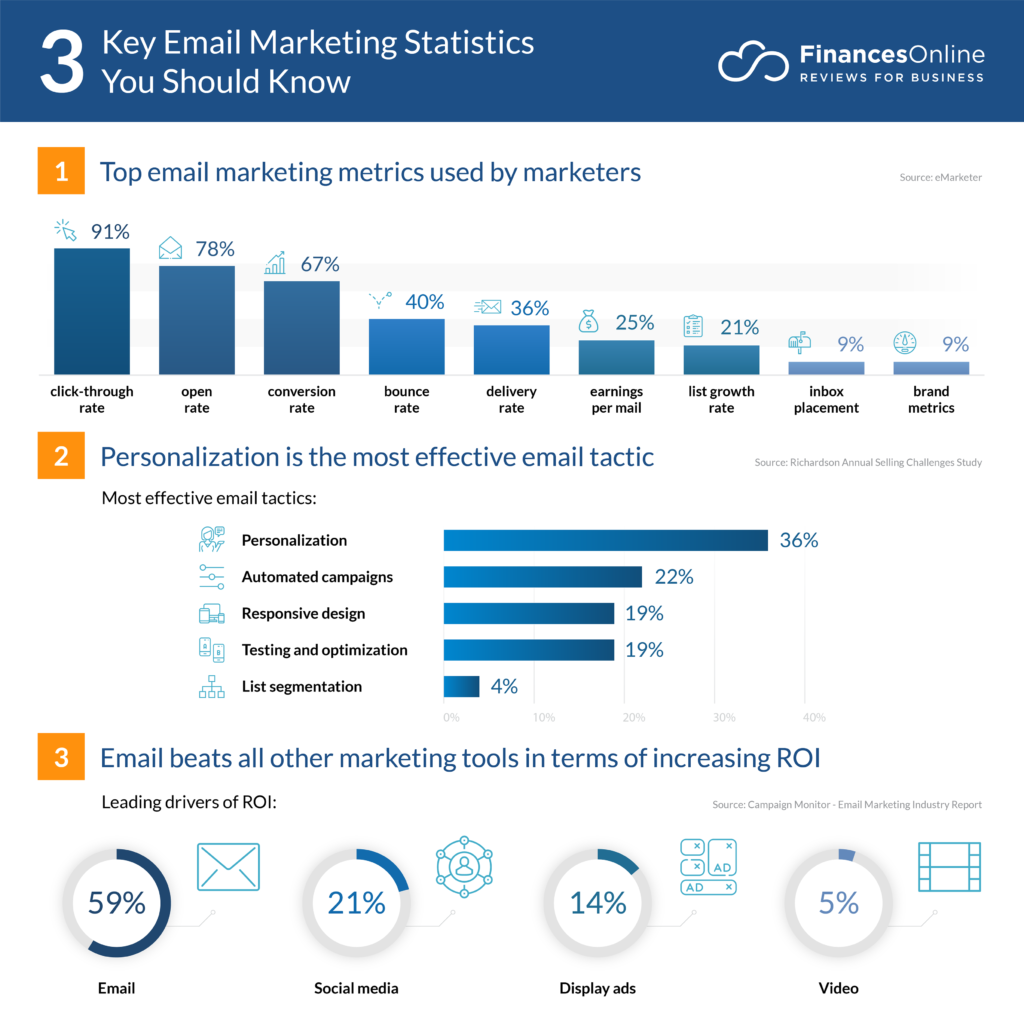
3 email marketing statistics you should know, from Finances Online
Email Marketing Best Practices
Email marketing is a powerful tool for engaging with your audience, building relationships, and driving business results.
To make the most of your email marketing efforts, here are some best practices to follow:
Build a Quality Email List: Focus on growing an organic and permission-based email list with subscribers who have explicitly opted to receive your emails. Avoid purchasing email lists to maintain engagement and deliverability.
Use a Professional Email Service Provider (ESP): Choose a reputable ESP to manage your email campaigns effectively. ESPs offer features like automation, analytics, and list management, ensuring your emails are delivered to the right audience.
Segment Your Audience: Divide your email list into different segments based on demographics, behavior, interests, or past interactions. Sending targeted emails increases relevance and engagement.
Personalization: Use recipient names and dynamic content to personalize your emails. Personalized emails have higher open and engagement rates.
Provide Valuable Content: Offer content that is informative, helpful, and relevant to your audience. Avoid constant self-promotion and focus on providing value.
Call-to-Action (CTA): Include a clear and compelling CTA that prompts readers to take action, such as visiting your website, making a purchase, or subscribing to a newsletter.
A/B Testing: Continuously test different elements of your emails such as subject lines, content, CTAs, and sending times, to identify what resonates best with your audience.
Optimize Email Design: Use a clean and visually appealing design that aligns with your brand. Ensure the email layout is easy to navigate and emphasizes important information.
Monitor Email Performance: Track key metrics like open rates, click-through rates, email bounce rates, conversion rates, and unsubscribe rates to measure the effectiveness of your campaigns.
Email Frequency: Find the right balance in how often you send emails. Avoid bombarding subscribers with too many emails, as it may lead to higher unsubscribe rates.
Follow Email Laws and Regulations: Comply with email marketing laws and regulations like the CAN-SPAM Act or the General Data Protection Regulation (GDPR) to avoid legal issues.
Maintain Consistency: Use consistent branding and messaging across your emails to build brand recognition and trust with your audience.
Optimize for Deliverability: Keep your email list clean by regularly removing inactive subscribers and addressing bounces. Use double opt-in to ensure list accuracy.
By implementing these best practices, you can create effective email marketing campaigns that resonate with your audience, drive engagement, and contribute to your overall marketing success.
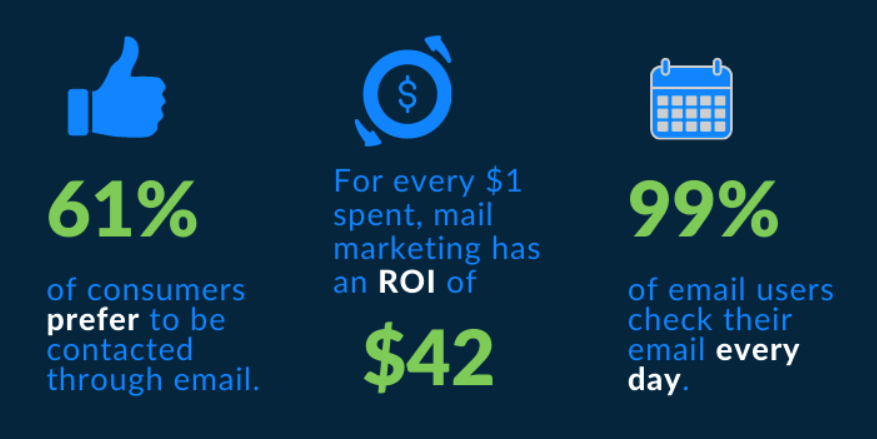
Source: Wordstream
FAQs – How to Write an Email
What points should you keep in mind while sending an email?
- Subject lines are important.
- Use bullet points and highlight your call to action.
- Keep it short.
- Don’t muddle content.
- Be collegial.
- Watch your tone.
- Avoid too many exclamation marks and emojis.
- Avoid quotes that could be offensive to others.
What to consider when sending an email?
- Make sure it’s not emotional.
- Check the subject line and make sure it’s on-topic and typo-free.
- Check the body for clarity.
- Check attachments and links.
What are things to keep in mind when sending an email?
- Use a direct subject line.
- Use a professional address.
- The “reply-all” button should be used sparingly.
- Add a professional email signature.
- Use professional greetings and respectful salutations.
- Be wary of excessive exclamation points.
- Be careful when using humor.
- Reply to all your emails.
- Avoid slang or emojis.
- Don’t use buzzwords.
- Be brief but clear.
- Use correct grammar.
- Always include a relevant subject line.
- Don’t put anyone down.
- Don’t forget the conversation closer.
Conclusion
Mastering the art of how to write an email is no small feat. It’s a blend of precision, professionalism, and clarity.
The recipient list can make or break your message. Double-check it every time.
Proofreading isn’t just for authors — it’s crucial in emails too. Typos and grammatical errors can undermine your credibility. Before hitting send, give it a thorough read.
Your subject line is like a headline — it should be clear, concise, and compelling. It should also give an accurate preview of what lies within your email body.
Brevity is key when drafting emails. Keep business emails short but meaningful to respect everyone’s time while ensuring understanding.
With these tips in mind, you can start writing emails that command attention and action without being intrusive or confusing.
Need help with writing marketing emails in bulk? BrandWell‘s AIMEE chatbot can help you write any type of marketing email — welcome emails, promotional emails, newsletters, abandoned cart emails, lead nurturing emails, survey emails, seasonal campaigns, and more. Just give it a quick prompt and your emails will be ready for sending in just a few minutes.

UNLOCK YOUR POTENTIAL
Long Headline that highlights Value Proposition of Lead Magnet
Grab a front row seat to our video masterclasses, interviews, case studies, tutorials, and guides.

